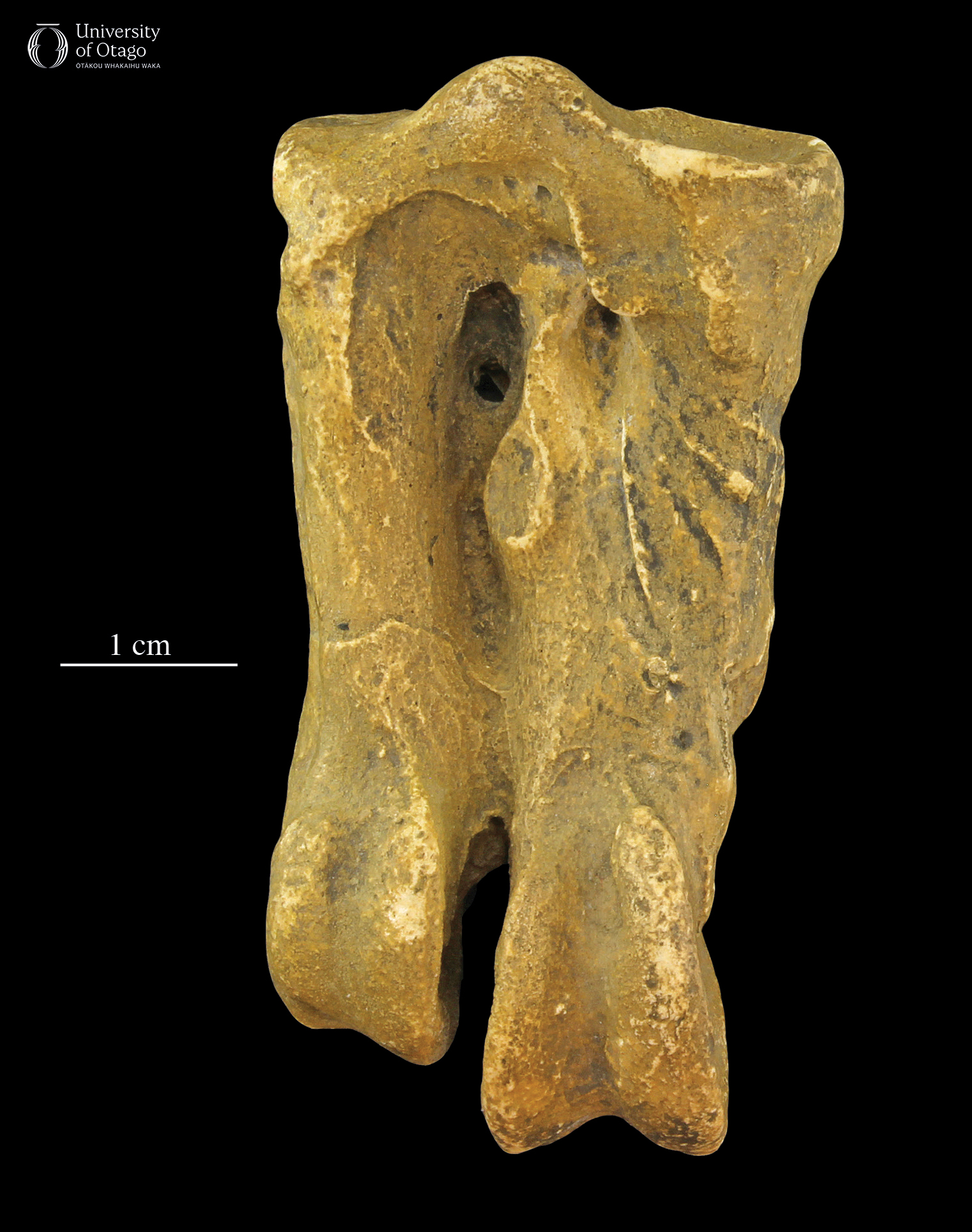28 Cast collection hallmark of international connections
Fossils curated by the University of Otago Geology Museum capture the incredible diversity of ancient life preserved across the South Island of Aotearoa. The Geology Museum also holds fossil taoka from elsewhere, including fossil fish and other specimens from the Chatham Islands. Among the great opportunities these collections provide to students and other researchers is that they enable comparisons with newly discovered fossils. And even though the fossil record of Zealandia has a wide cross section of biodiversity, sometimes the best specimens for comparison are housed in other museums. To support these comparisons the Geology Museum also holds replicas of a small number of important fossils from around the world.

Ankle bone (tarsometatarsus) from the fossil penguin Palaeeudyptes antarcticus (cast of specimen BM A.1048). This cast is one of many similar objects in the Geology Museum collection. Image credit: JH Robinson. |
The process of producing and sharing replicas of fossils between museums is a long-standing tradition for promoting research. The most important quality of a replica is its ‘fidelity’ or faithfulness to the original object. A high-fidelity replica of a fossil captures details at the smallest scale needed to be useful for study. Such replicas have traditionally been created by producing a mould of the fossil using a thin polymer, and then making a cast from that mould. High-fidelity casts of fossils from the Geology Museum can be seen on display at the Vanished World Centre in Duntroon. Similarly, the Geology Museum holds a small collection of high-fidelity casts from several museums around the world.
One especially important example in the Geology Museum collections is the broken ankle bone from a giant penguin. This story about the giant penguin and the cast was written by Ewan Fordyce:
“..The first penguin fossil recognised to science was a dramatically large incomplete ankle bone from Kakanui, on the coast of North Otago. The bone was acquired by Government Agent Walter Mantell during his travels in Otago in late 1848, and was sent to Britain where it was studied by the pre-eminent paleontologist T.H. Huxley. Huxley announced the find in the Quarterly Journal of the Geological Society in March 1859. There he identified the bone as from a new genus and species of penguin which he named Palaeeudyptes antarcticus – literally, ancient winged diver of the south. The ankle bone or tarsometatarsus is perhaps the single most distinctive bone in penguins and, had he been presented with some other bone, Huxley might have found it more difficult to convince people that the fossil was from a penguin.
Within a few decades, other fossil penguin bones were reported from New Zealand, both from North Otago and from Westland. Again, the bones clearly represented species larger than those of today. Because of their size, the fossils were thought to represent more individuals of Huxley’s new species, Palaeeudyptes antarcticus. However, no ankle bones were known amongst the new specimens, and it could not be confirmed that all the fossils really did represent the one species. Indeed, despite 150 years of field work, no more material of Huxley’s species has been found – the species Palaeeudyptes antarcticus is still known from one incomplete bone. So, the name can be used confidently only for the one fossil which resides in a drawer in the Natural History Museum, London. Finally, we aren’t even sure of the age of the fossil; it is probably from the soft white Ototara Limestone which, at Kakanui, spans the Eocene/Oligocene boundary – in the range 32-34 million years ago. However, the bone could be from the harder and younger Otekaike Limestone, with an age of perhaps 23-24 million years..”
The Geology Museum’s cast of the tarsometatarsus from Palaeeudyptes antarcticus has contributed to the research of postgraduate students and visiting researchers for several decades.
—Written by Daniel B Thomas, with a contribution from R. Ewan Fordyce
Evidence of life from a past geological age. Remains like bones, shells or wood, or an impression like a footprint, or some other evidence of life, from something that was alive more than 11,700 years ago.
Te reo Māori term originating with Kāi Tahu meaning treasured. The term taonga in te reo Māori is also used for treasured.
A collection of fossils that document the history of life. Reference might be made to the history of life in a particular place ('the fossil record of New Zealand'), or the history of a particular group of organisms ('the fossil record of penguins'), or simply the global history of all life ('the fossil record').
The mostly submerged continent of which New Zealand and New Caledonia are a part.
The variety of life.
Part of the UNESCO Waitaki Whitestone Geopark. See: Vanished World Centre.
Penguins. An order of seabirds with around 20 living species in a single family (Spheniscidae). Many more extinct species of penguin are known compared with the number of living species.
Bone in the hindlimb of a bird. Forms part of the foot. This bone is a fusion of the tarsal and metatarsal elements that would be found as separate bones in some other reptiles or in mammals.
Well-sorted bryozoan limestone.
56 to 33.9 million years ago.
33.9 to 23.03 million years ago.
Coarse-grained, sandy limestone.

